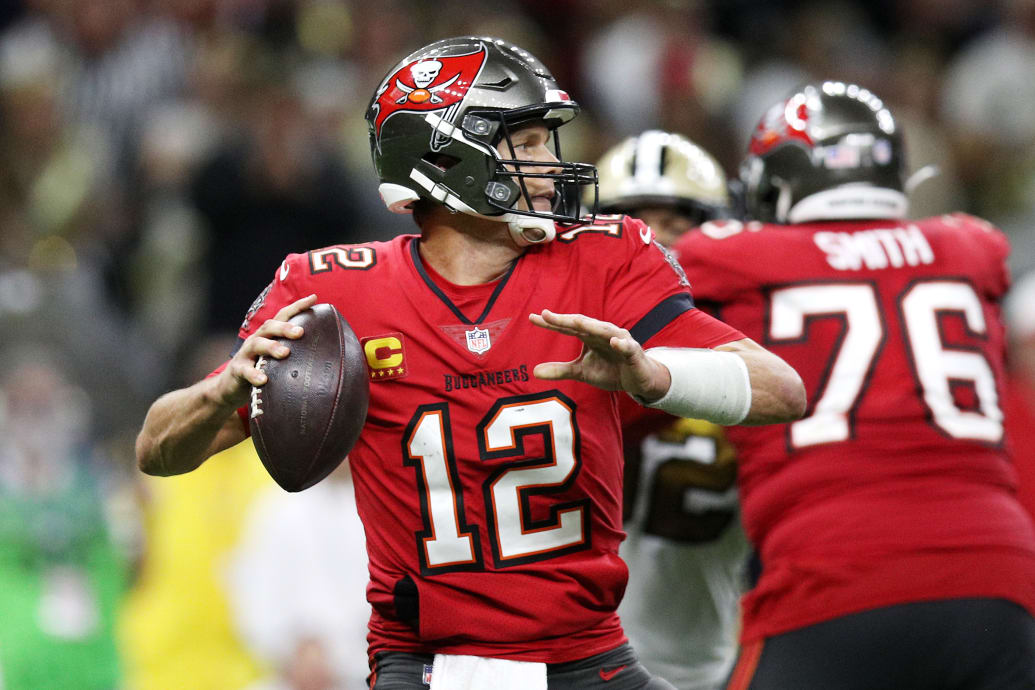Why Pro Athletes Like Aaron Rodgers Are So Susceptible to Medical Quackery
Yesterday it was revealed that Aaron Rodgers, quarterback for the NFC-leading 7-1 Green Bay Packers and the reigning NFL MVP, has been stricken by COVID-19. It was also sort-of revealed that Rogers has not been vaccinated against COVID, despite being a traveling athlete who is in close proximity to a bunch of people all the time.
This second reveal came as something of a surprise to NFL watchers, because back in August, Rogers told reporters during a press conference that he was “immunized” against the virus. Not vaccinated, mind you, but “immunized.”
Now, what did he mean by that? Apparently, Rogers pursued a homeopathic alternative to vaccination from his personal doctor, and tried to get the league and the Players’ Union to categorize him as immune enough to be considered fully vaccinated. They said no, this is fake, and then subjected him to all of the league’s protocols for unvaccinated players, which include a minimum 10-day quarantine for anyone who tests positive.
So, here we are: A quarterback who makes $33 million a year, who once won on Celebrity Jeopardy and mostly seems like a fairly rational guy (aside from his supposed belief in chemtrail conspiracy theories), got sidelined because he got a disease that you can be immunized against with the help of two brief injections of a vaccine that is safe and effective. Once again, the actions of a public figure bring to mind the official mantra of COVID-19: “Fuck around and find out.”
What is vaccine hesitancy? A lot of things, really. It’s a conspiracy theory, a manifestation of the American public’s distrust of doctors and Big Pharma—distrust that comes from reasonable and unreasonable places alike. It’s a movement, and was one before anyone even heard the word “COVID.” In 2019, Vancouver, Washington, where I live, experienced an outbreak of measles, fueled by vaccine conspiracies that were pushed in insular Russian-speaking communities on social media.
The modern anti-vaccine movement was kicked off by a widely discredited study conducted by the British Doctor Andrew Wakefield that suggested autism could be caused by the widely distributed MMR Vaccine. Instead of backing off when his outlandish claims were demolished by peer review, Wakefield instead created a nice little career for himself as a public vaccine skeptic who stokes the concerns and flatters the intellect of parents who are inclined to fear something they can’t intuitively understand. Because more than anything else, vaccine hesitancy is bunk. It’s anti-science nonsense that fits neatly over a bunch of political and metaphysical molds—a tool for grifters to cultivate suspicion where none should rationally exist.
It appears that one of these grifters has managed to latch onto Aaron Rodgers and blow up his NFL season. But, in this at least, Rodgers can sleep well knowing that this is a fairly common occurrence among pro athletes. The pro athlete cohort is uniquely susceptible to medical nonsense, and has been for quite some time.
Consider the case of Jim Galvin, a late-19th century pitcher. Christened “Pud” because his scorching-hot fastball would turn opposing pitchers into pudding at the plate, Galvin was also an elite defensive pitcher with a monstrous pickoff move—he once picked off three runners in a single inning—who threw two no-hitters and made himself into a Hall of Famer despite his relatively short stature.
But, as it does for all athletes, time eventually took its toll. Galvin, unwilling to let go, pursued a “cutting edge” solution for aging: dog testosterone. In 1889, Pud volunteered for a hormone-replacement study being conducted by Charles-Édouard Brown-Séquard, a French-American doctor and neurological pioneer. He was injected with the “Brown-Sequard Elixir,” a concoction of extracts made from guinea pig and dog testicles.
It should go without saying, but I need to stress: guinea pig testosterone is not actually a viable performance enhancer in human beings, and any improvement someone might experience from the shot is attributable to the placebo effect. But Brown-Séquard was convinced it helped him rejuvenate himself, and managed to convince ol’ Pud that it would do the same. When he managed to get his mojo back after getting dog nut juice shot into his arm, he, and the press, gladly credited the improvement to Dr. Brown-Séquard’s voodoo mixture.
This is all to say: half-baked medical thinking has been a part of professional sports since the beginning of professional sports. Many of our finest dodgy athletic therapy trends are popularized by pro athletes looking for the holy grail of perfect eternal performance. A lot of it is nonsense, of course, and some of it is best described as “a grift.” But grifting resides on a spectrum. Athletes might know, intellectually, that this crap doesn’t “work” in the scientific application of that word, but pro sports are a tremendously stressful, all-consuming pursuit, and any mental edge that someone can find, even if it’s transparently a placebo, can help in a world where success is determined by the fluctuations of one’s finger muscles.
Some of these pursuits are transparent lies on the part of the companies who make and shill them. Take, for instance, the Power Balance Bracelet, a bracelet with… a hologram in it that its manufacturers claimed improved balance. The company was forced to pay out a $57 million class-action settlement for making bunk claims about their HoloBracelets, but not before they got Lamar Odom to invest in their company and paid Shaq to cut an ad for them.
Tom Brady, a public lunatic who used to play quarterback for the New England Patriots (and who managed to get vaccinated), has long ascribed to the theories of Alex Guerrero, a “body coach” who once got dinged by the FTC for peddling fake concussion cures. The two of them have gone into business together, promoting the TB12 Method, a training regimen that de-emphasizes traditional strength training in favor of a concept known as “pliability.” Our muscles, you see, get injured more easily when they are stiff like wood. But if you train to make them soft, they will not break. They will, instead, absorb the stress and impact of athletic activity.
None of this is true, of course. But that didn’t stop the Patriots, seeking to appease their star quarterback, from contracting Guerrero and TB12 to assist with the team’s athletic training at a facility the company built across the street from the Patriots’ practice facility. When the Patriots concluded that TB12’s methods might have contributed to some injury problems on the team, Guerrero was exiled from the building. This created a rift that led to Brady’s departure from the team. His new squad, the Tampa Bay Buccaneers, are more open to Guerrero’s whims.
It’s tempting to read all this and think it’s purely a matter of money: TB12 is Brady’s business, their success depends on athletes embracing and promoting pliability or whatever, and the Patriots slighting Guerrero affected the bottom line. But anyone taking stock of Tom Brady as a human being will realize one thing: he is obsessed with football, obsessed with self-improvement, and obsessed with doing everything in his power to stay on the field as long as he possibly can. He’s still a starting quarterback at the age of 44, a whopping five years older than Peyton Manning, who played his final seasons with a fused vertebrae in his neck.
Guerrero’s methods are almost certainly not what is keeping Brady on the field right now. But what this whole mechanism does offer him is a sense of control over his body. Brady needs to step on that field with the utmost confidence that he is fine-tuned for football destruction. This whole rigmarole is a way of convincing himself that he is ready in a way that no one else could ever be; a long-term psych-up that helps him deliver.

Tom Brady #12 of the Tampa Bay Buccaneers looks to throw the ball during the fourth quarter against the New Orleans Saints at Caesars Superdome on Oct. 31, 2021, in New Orleans, Louisiana.
Sean Gardner/Getty
In 2013, on the eve of the Super Bowl, Sports Illustrated published a kind-of profile of ‘S.W.A.T.S.,’ a sports technology concern that sold every form of BS you can possibly imagine: ionized water (not real), holographs (even less real), deer antler spray (doesn’t work, and if it did, it would be a PED). David Epstein, a writer whose work often combines sportswriting with popular science, tells this story with what amounts to open contempt for the snake-oil salesmen who are profiting off this nonsense. It’s all completely laughable. But hey, look toward the end: there’s Ray Lewis, legendary Ravens linebacker, probably the best defensive player of his generation, applying holographic “pain chips” to his sore elbow.
What does he find in pain chips? Once again: a sense that he’s doing something for himself. Pro sports is an industry that does everything in its power to take it from you. Teams insist on their own training methods, encourage you to play through injury, and require a degree of dominion over your body in order to grant you a paycheck. The pursuit of alternative methods, even ones based on specious logic, allow athletes to put some distance between themselves and an industry that simply does not value their bodies as much as they themselves do.
In a way, I think this impulse explains something about vaccine hesitancy. American medical care is a nightmare. Patients are at the mercy of penny-pinching insurance companies, the medical establishment is riddled with racial biases, many people simply can’t afford to engage with a trusted primary care provider, it goes on and on. The whole system is built to impose a lack of control on anyone who isn’t wealthy. Why wouldn’t this lack of control over one’s own health, and the misery it creates, make people suspicious of medicine as a practice? Isn’t it natural for someone whose interactions with doctors are riddled with other people’s self-interests to believe that doctors are purely agents of profit?
Aaron Rodgers’ conspiratorial thinking comes from a place of profound, bizarre privilege, of course. The shot obviously works and will not make you grow tentacles, dingus. But when your sense of biopower is compromised by forces that simply don’t have your best interests at heart, you naturally might become a little suspicious.


